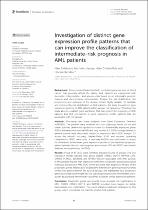| dc.contributor.author | Eshibona, N | |
| dc.date.accessioned | 2023-03-30T10:27:35Z | |
| dc.date.available | 2023-03-30T10:27:35Z | |
| dc.date.issued | 2023 | |
| dc.identifier.citation | Eshibona, N., Livesey, M. and Christoffels, A., 2023. Investigation of distinct gene expression profile patterns that can improve the classification of intermediate-risk prognosis in AML patients. | en_US |
| dc.identifier.issn | 1664-8021 | |
| dc.identifier.uri | http://hdl.handle.net/10566/8709 | |
| dc.description.abstract | Acute myeloid leukemia (AML) is a heterogeneous type of blood cancer that generally affects the elderly. AML patients are categorized with favorable-, intermediate-, and adverse risks based on an individual’s genomic features and chromosomal abnormalities. Despite the risk stratification, the progression and outcome of the disease remain highly variable. To facilitate and improve the risk stratification of AML patients, the study focused on gene expression profiling of AML patients within various risk categories. | en_US |
| dc.language.iso | en | en_US |
| dc.publisher | Frontiers In Genetics | en_US |
| dc.subject | acute myeloid leukemia | en_US |
| dc.subject | risk classification | en_US |
| dc.subject | intermediate-risk | en_US |
| dc.subject | gene expression | en_US |
| dc.subject | prognosis | en_US |
| dc.title | Investigation of distinct gene expression profile patterns that can improve the classification of intermediate-risk prognosis in AML patients | en_US |
| dc.type | Article | en_US |

